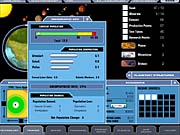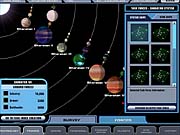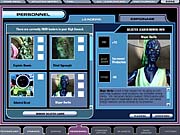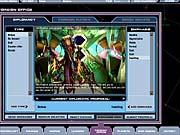Master of Orion III Preview
We take an updated look at this highly anticipated strategy sequel.
Finishing up the development of Master of Orion III hasn't exactly been a Sunday drive. At the beginning of the year, the game was still said to be on track for a June release, but things have gone off course since then. Early last month, Infogrames revealed that the release date had been pushed back to this fall to give Quicksilver time to streamline and simplify the design. The design changes that have followed are more than simple tweaks. Some of the unique design decisions made by the original designer to balance micro- and macromanagement made it so the game was doing "too much for the players" and just wasn't fun. But the team has gone through each part of the game to set things right. The result is said to be similar in gameplay style to the first Master of Orion game, which garnered quite a following when it came out in 1994. We talked to Constantine Hantzopoulos, the game's producer at Infogrames, to get a sense of what the final game will be like after all these changes.

The broad scope of conquest games like Master of Orion III--or even Civilization III--means that they're made up of many different components: diplomacy, espionage, combat, research, production, and management. While the separate parts of Master of Orion III have been working for some time, it was only late last year that the developers could put them all together. The streamlining process doesn't involve changing the individual parts of the game--it's been more of a rebalancing of how things come together. Part of this is just simplifying the game's interface. There were some 160 interface screens in the original design, and it wasn't always easy to find a simple bit of information, like whether your economy was turning a profit. That number has been cut roughly in half, and contextual menus make most screens directly accessible from the main view.
Some distinctive elements of the game's design have been cut or significantly reworked. The centerpiece of Master of Orion III's ambitious design was the concept of "imperial focus points," which was meant to address the pacing problem large-scale strategy games often have late in the game, when there's too much for a player to manage comfortably. In a real government, we'd expect a bureaucracy to develop to deal with the management headache of an ever-growing empire. Focus points meant that a player could only have so much influence on the game, and the bureaucracy--an extensive system of automation--would handle the rest. Unfortunately, the result was that the players would spend as much time considering how to manage an empire as actually managing it.

The good news is that the developers have found a way to keep the essence of the focus point system and get rid of the artificial limits on how much a player can control. The AI developed to run your empire is still in the game, and players can rely on it more or less according to taste. You can set broad, empire-wide policies for the AI to follow, specify a production focus for a given planet or system, let the AI handle space combat, or handle any given element yourself. The design is more open to different styles of play, and it still tries to cut down on the need for late-game micromanagement. Yet, there's the idea that empires are hindered by bureaucratic inertia as they grow, which the developers call the "heavy foot of government." Things just cost more for larger empires, so it's possible for smaller competitors to make a comeback, and dominant powers can benefit from keeping smaller allies around as efficient economic partners.
More Changes

The changes that Quicksilver is making affect much more than the focus points system. The "ethos" system, something like religion, was completely cut from the game last November because it was too subtle. As Constantine Hantzopoulos put it, ''Every action needs a reaction, but with ethos a player wouldn't see a reaction for 300 turns." The game's leaders have also been reworked. While the game used to track leaders from top to bottom through your empire's chain of command, the scope of this system didn't give any one leader any personality. Now there are just 40 to 50 leaders in the game, and they make significant empire-wide modifications, such as a 20 percent bonus to your fleet's capabilities or an increase in planetary production. This change is intended to strengthen the political and espionage elements of the gameplay. As Hantzopolis explained, now that "...leaders have this godlike status, they're real targets." You can send your spies to assassinate or bribe a key leader, and it can make a big difference. An empire won't have an ever-growing stable of leaders, though, since they appear and disappear from the game through random or triggered events.
While the "ethos" is out, there are plenty of political considerations left in the game. In addition to the various characteristics of the game's 16 playable races, there are different government types that are more or less efficient. For example, forced labor is one option for increasing productivity, but naturally taking the oppressive route has its consequences. Shorter life expectancies are one effect. And depending on the level of oppression or freedom in an empire, citizens are more or less happy. Unhappy citizens will simply try to leave, and these push-and-pull factors have a noticeable effect on your population's size. When you capture planets, the native populations aren't automatically assimilated, but you can help reduce the likelihood of these potential workers leaving or revolting by building the right structures or setting policies of toleration.

Conquest is naturally a part of space-empire games, but Master of Orion III's ship combat seems surprisingly involved. The combat is real time and very tactical, very much in the style of Quicksilver's own Starfleet Command. While the focus point system used to mean that the AI nearly always fought battles for you, there's now an added layer of control for players who want it. When fleets engage, they don't automatically line up face-to-face with each other like in the previous game in the series. Instead, players can position their forces to tactical benefit, even holding some ships in reserve. Battles can be quite big, in the range of 500 to 700 ships, but ships are grouped in task forces to keep things manageable. If the battle's outcome is a foregone conclusion or just you're not interested in the tactical details, the AI still should be able to handle things capably. Once you've penetrated a planet's defenses, ground combat is handled more abstractly. Combat is resolved automatically in a "radio show" view that gives you a play-by-play account of the action. Worlds are also now broken up into regions, each of which has a terrain type. Ground combat is simple, but it is a real strategic consideration, since it can take several turns to pacify a challenging ground force.
Not Just Conquest
Another element that's more fully developed in Master of Orion III than in its predecessors is diplomacy. The developers are attempting to make the game's diplomacy resemble that of Accolade's classic action-strategy hybrid Star Control II--in other words, the different races will have a lot of personality. When you negotiate with another empire, you see an animated character who uses the body language distinctive to that race. The animations aren't prerendered, but instead put together elements on the fly. Depending on the diplomatic mood, you could well see an alien screaming at you with tentacles waving, bowing benevolently, or looking coldly indifferent. There's an advisor to help suggest some possible offers, but you can steer your own diplomatic course by specifying an action and one of six moods for the conversation.

Although most of the individual parts of the game are considered done, there's still quite a bit left for the developers to do before it comes out this fall. The team's main tasks are to balance how involved the player has to be with micro- and macromanagement tasks and continue to streamline the game so that it can be played fairly quickly. Hantzopoulos says his ideal would be for the game to require no more time to play the last turn than the first turn. He admits that won't quite happen, but between slowly introducing advanced tasks like ship design over the course of the early game and using automation to keep down the number of details a player needs to balance in the late game, the game's ambitious design may be streamlined for the better. Turns should take two to 10 minutes to play on average. A single-player game on a small map could be played in as little as 45 minutes, but there's the option to play much deeper games as well, and a huge map with thousands of stars could take weeks to finish.
The faster play style will also have an effect on the multiplayer game. Strategy games with such broad scope often make for multiplayer games that are unwieldy for all but the most serious fans, but Master of Orion III does have some features to make online play smoother. For instance, players take turns simultaneously to reduce waiting. To keep things rolling, there's an option for timed turns, but even without timed turns, players are motivated to play quickly. The longer it takes you to take your turn, the more interest you pay on a treasury deficit and the less you earn on a surplus, and players who finish early get an interest bonus.

There's no doubt that Master of Orion III is an ambitious game. At past demonstrations of the concept, we've heard more about it than we've seen. After two years of development, Infogrames wants to be sure there's a solid, playable game to ship. Some of shifts at Quicksilver seem pretty drastic--between the design changes and the departure of the game's original designer, Alan Emrich--but it seems that Infogrames made the right choice not to force the game to ship this June." On the new schedule, the game instead just has to be feature-complete, or alpha, this June. We're certainly eager to get our hands on a playable version and see how it develops the legacy of the Master of Orion series.
Got a news tip or want to contact us directly? Email news@gamespot.com
Join the conversation